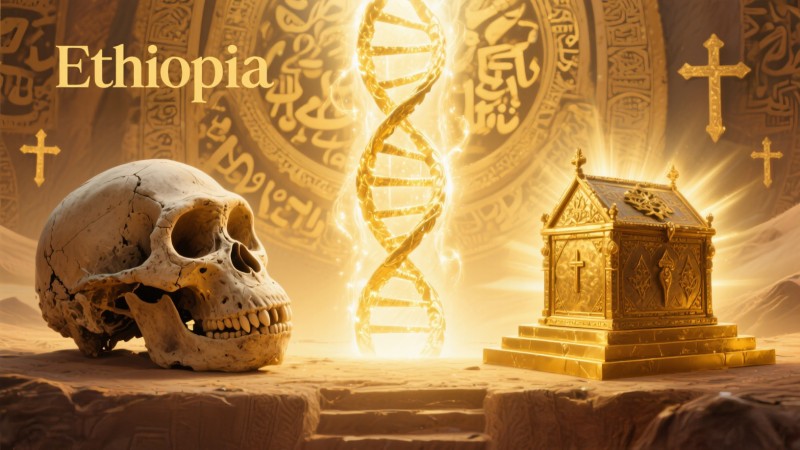Ethiopia: The First Code — Humanity, Holiness, and the Hidden Ark

"Ethiopia shall soon stretch out her hands unto God." — Psalm 68:31 (KJV)
Ethiopia is not just a nation—it is a convergence point of science, myth, spirit, and memory. From the ancient bones buried beneath its soil to the sacred relics whispered to lie within its chapels, Ethiopia may hold more than just the key to humanity’s past—it may hold the code to its future.
Cradle of Mankind and the Genetic Eden
In the Afar Depression of Ethiopia, paleoanthropologists discovered Lucy, the 3.2-million-year-old Australopithecus afarensis, alongside Ardi and Selam—skeletons that trace the early steps of bipedal, intelligent life. These aren’t just fossils—they are the foundation of our biological identity.
Modern genetics confirms what ancient bones have already suggested: Ethiopia is the birthplace of humanity. Both Mitochondrial Eve and Y-Chromosomal Adam—the maternal and paternal common ancestors of all humans—trace back to East Africa. Ethiopia, in every meaningful way, is our genetic Eden.
But the discoveries didn’t end with origins. In 2012, a landmark genetic study (Pagani et al.) found that Ethiopia is more than just a beginning—it’s a genetic time capsule. While other African regions remained relatively isolated, Ethiopia became a bridge where ancient Eurasian, Middle Eastern, and African lineages met and mixed. Traces of Neanderthal and even Denisovan DNA—previously thought absent in Africans—were found here, challenging and reshaping our understanding of evolution.
Ethiopians carry unique genetic adaptations—genes like BHLHE41 (regulating sleep cycles), APOL1 (protecting against sleeping sickness), and others influencing resistance to malaria, tuberculosis, and even COVID-19. Some variants are linked to cognitive function, language processing, and athletic ability. Ethiopia is not just a relic of early man—it may be a blueprint for future humanity.
This diversity also preserves echoes of lost civilizations. The Beta Israel, Ethiopian Jews, carry the Cohen Modal Haplotype, a genetic marker linked to ancient Israelite priesthood. Through them, the story of Menelik I and the Ark of the Covenant is no longer just legend—it’s inscribed in the body.
And from the Harla people to the Aksumite Empire and Nubian dynasties, ancient cultures live on in modern DNA, layered by centuries of trade and contact with India, Arabia, Rome, and Persia. Ethiopia became not only a womb, but a melting pot of civilizations. The Ethiopians literally have DNA markers from around the world. They are connected to ancient DNA more than modern DNA. Genetic markers found in Ethiopians today connect them to India, Ancient Egypt, Asia, and the Middle East, revealing ancient migrations and shared ancestries that span continents. This deep interconnection is not only biological but spiritual—Ethiopia remains one of the few places on Earth where Christianity, ancient Judaism, and Islam have coexisted in harmony for centuries, woven into the cultural fabric of a singular people.
Biblical Eden and the Land of Cush
Biblical scholars have long noted Ethiopia’s resemblance to Eden. In Genesis 2:13, it is written: "The name of the second river is Gihon; it is the one that flows around the whole land of Cush." Cush is consistently identified with ancient Ethiopia.
The Blue Nile, sacred lakes, and lush valleys of Ethiopia match the symbolic geography of Eden. If Eden was real, its fingerprints are likely found here—in the soil, in the scripture, and in the cells.
Ancient Christianity: Flame of the First Faith
By the 4th century CE, Ethiopia became one of the first nations to adopt Christianity. The Ethiopian Orthodox Tewahedo Church predates many Western traditions and still reads from ancient texts—some banned from modern Bibles. It speaks in Ge'ez, a language older than Arabic or Hebrew.
Its rituals preserve Hebraic customs—dietary laws, Sabbath observance, and deep veneration of the Ark—making Ethiopia a rare culture where Judaism and Christianity never parted ways. This isn’t a borrowed faith. It is an ancestral fire, burning without interruption.
The Ark of the Covenant in Axum
At the Church of Our Lady Mary of Zion in Axum, a single monk guards what many believe is the original Ark of the Covenant. According to Ethiopian tradition, the Ark was brought to Ethiopia by Menelik I, son of King Solomon and the Queen of Sheba.
No outsider has seen it, and yet, the belief is unshakable. Pilgrims gather. Priests protect. And the legend lives on, sustained by bloodlines, rituals, and genetic echoes.
The CIA and the Remote Viewing of the Ark
In the 1980s, during Cold War psychic programs like Project Stargate, the CIA employed “remote viewers” to psychically observe targets across time and space. One such session focused on the Ark of the Covenant.
The results were eerie. Viewers described a golden object of immense energy, placed within a stone building in Ethiopia, surrounded by spiritual guardianship and geometry. They saw the Ark not as symbolic—but as a technological relic, capable of influencing matter and consciousness.
These findings weren’t broadcast. But in the language of intelligence agencies, what’s not denied is often most true.
Fractal Origins: A Code That Repeats
Some may even argue that the true chosen people—those who carried the original spark of life, culture, and covenant—were not the Israelites alone, but the Ethiopians. Their genes hold ancient signatures. Their rituals preserve the echoes of Eden. Their lands cradle relics of both science and scripture.
In a fractal universe, beginnings are not linear—they echo, branch, and return. Ethiopia is not just the start. It is a repeating pattern in the human story:
Biological origin (Lucy)
Genetic origin (Eve and Adam)
Spiritual origin (Christianity and Judaism)
Mythic-technological origin (the Ark)
Ethiopia is not a backdrop. It is the central node of the fractal—the First Code where mind, body, and soul were imprinted into the human experience.


Leave a comment